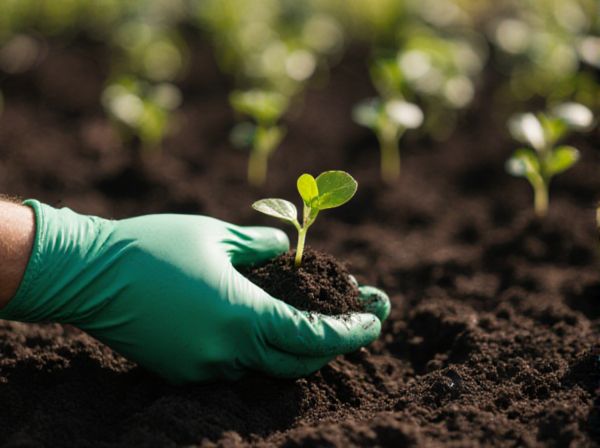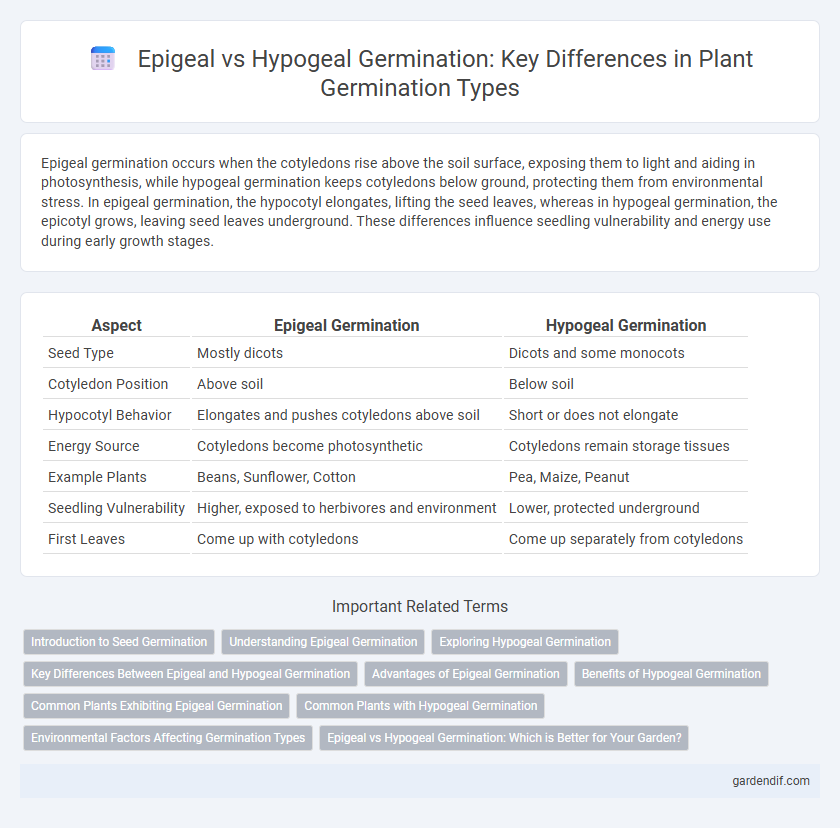
Epigeal Germination vs Hypogeal Germination Illustration
Epigeal germination occurs when the cotyledons rise above the soil surface, exposing them to light and aiding in photosynthesis, while hypogeal germination keeps cotyledons below ground, protecting them from environmental stress. In epigeal germination, the hypocotyl elongates, lifting the seed leaves, whereas in hypogeal germination, the epicotyl grows, leaving seed leaves underground. These differences influence seedling vulnerability and energy use during early growth stages.
Table of Comparison
| Aspect | Epigeal Germination | Hypogeal Germination |
|---|---|---|
| Seed Type | Mostly dicots | Dicots and some monocots |
| Cotyledon Position | Above soil | Below soil |
| Hypocotyl Behavior | Elongates and pushes cotyledons above soil | Short or does not elongate |
| Energy Source | Cotyledons become photosynthetic | Cotyledons remain storage tissues |
| Example Plants | Beans, Sunflower, Cotton | Pea, Maize, Peanut |
| Seedling Vulnerability | Higher, exposed to herbivores and environment | Lower, protected underground |
| First Leaves | Come up with cotyledons | Come up separately from cotyledons |
Introduction to Seed Germination
Seed germination begins with water absorption, activating metabolic processes that enable embryo growth. Epigeal germination involves the cotyledons emerging above the soil surface, exposing them to light for photosynthesis. In contrast, hypogeal germination keeps cotyledons below the soil, relying on the hypocotyl to push the plumule upward.
Understanding Epigeal Germination
Epigeal germination occurs when the cotyledons are pushed above the soil surface by the elongation of the hypocotyl, allowing them to become photosynthetically active. This type of germination is common in plants like beans and sunflowers, where cotyledons provide energy early in development while also contributing to photosynthesis. Understanding epigeal germination is crucial for optimizing seedling growth conditions and improving crop yield in agriculture.
Exploring Hypogeal Germination
Hypogeal germination is a process where the cotyledons remain below the soil surface, protecting the seed's energy reserves during early growth stages. This type of germination is common in plants like peas and maize, promoting resilience in adverse environmental conditions by shielding vital tissues underground. The slower emergence of the shoot allows seedlings to establish stronger root systems before exposure to surface hazards.
Key Differences Between Epigeal and Hypogeal Germination
Epigeal germination involves the cotyledons rising above the soil surface as the hypocotyl elongates, while in hypogeal germination, the cotyledons remain below ground due to epicotyl growth. Epigeal seedlings generally have cotyledons that become photosynthetic and contribute to early growth, whereas hypogeal seedlings rely on stored nutrients in the cotyledons underground. Species such as beans exhibit epigeal germination, contrasted by peas which display hypogeal germination, reflecting adaptations to different environmental conditions.
Advantages of Epigeal Germination
Epigeal germination offers advantages such as rapid seedling emergence and early access to sunlight, which enhances photosynthesis and growth rates. The cotyledons are elevated above the soil, facilitating nutrient absorption and reducing vulnerability to soil pathogens. This method supports quicker establishment and competitive growth in open environments.
Benefits of Hypogeal Germination
Hypogeal germination offers enhanced protection to the emerging shoot by keeping the cotyledons below the soil surface, reducing vulnerability to herbivores and environmental stress. This underground positioning also conserves moisture and energy, promoting better seedling survival in harsh conditions. Plants with hypogeal germination often show increased resilience and a higher chance of successful establishment in nutrient-poor or dry soils.
Common Plants Exhibiting Epigeal Germination
Common plants exhibiting epigeal germination include beans, sunflowers, and cotton, where the cotyledons are pushed above the soil surface during sprouting. This type of germination allows the cotyledons to perform photosynthesis, contributing to early plant growth. Epigeal germination is characterized by a rapid upward growth of the hypocotyl, unlike hypogeal germination where cotyledons remain underground.
Common Plants with Hypogeal Germination
Common plants with hypogeal germination include peas, maize, and beans, where the cotyledons remain below the soil surface during seedling development. This type of germination protects the food reserves underground, allowing the shoot to emerge without exposing the cotyledons to environmental stress. Hypogeal germination is advantageous in harsh climates, enhancing seedling survival by safeguarding essential nutrients underground.
Environmental Factors Affecting Germination Types
Epigeal germination thrives in environments with abundant light and moderate soil moisture, as the cotyledons emerge above the soil surface and perform photosynthesis. Hypogeal germination is favored in shaded or nutrient-poor conditions, where the cotyledons remain below soil, protecting them from herbivores and adverse weather. Temperature, soil oxygen levels, and moisture content significantly influence the success rates of both germination types, impacting seedling vigor and survival.
Epigeal vs Hypogeal Germination: Which is Better for Your Garden?
Epigeal germination exposes the cotyledons above soil, promoting faster photosynthesis and early growth, ideal for warm-season crops like beans and pumpkins. Hypogeal germination keeps cotyledons underground, protecting them from pests and adverse weather, benefiting cool-season plants such as peas and spinach. Choosing between epigeal and hypogeal germination depends on your garden's climate, plant type, and desired growth speed for optimal yield.
Epigeal Germination vs Hypogeal Germination Infographic

 gardendif.com
gardendif.com